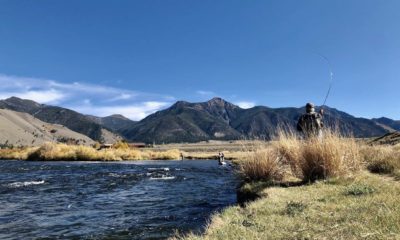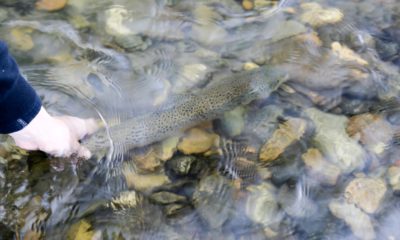Uncategorized
Nymphing: fly fishing’s misunderstood art
Published
10 years agoon

By Patrick Straub
Explore Big Sky Fishing Columnist
This might sound like the beginning to Norman Maclean’s treatise in “A River Runs Through It and Other Stories,” but in my family there was no clear line between work and outdoor recreation. I grew up in the foothills south of Bozeman where I fished with my brothers and watched my parents help others enjoy the outdoors – my mom as a career ski instructor and my father as a camp manger in Paradise Valley. Summers were spent bloodying shins on the rocks of small creeks and winters picking lines off Bridger Bowl’s ridge.
I learned to fish dry flies at a young age and when the fish would not eat a Coachman Trude or a Royal Wulff, I would occasionally throw a woolly bugger. It wasn’t until college when I finally understood and appreciated the subtleties of fishing flies sub-surface. This progression is not unique to my angling background, as many of us started with single dry flies and have progressed to long leaders with strike indicators, split-shot, and two-weighted flies on fluorocarbon tippets.
Why did things get so complicated? Because we like to catch fish, that’s why. It took me a while to successfully fish nymphs. Few things in angling top watching a fish eat your dry fly on the surface, but the more you can successfully fish flies under the surface, the more fish you’ll catch. Here’s some help that I never had.
Look at the big picture. Fishing nymphs requires an in-depth – pun-intended – look into the angling scene. When fishing dry flies you’re often focused only on the surface. Nymphing adds the elements of current speed, underwater structure and depth to the equation. You must determine the proper amount of weight on your leader, fly size, getting a proper drift, detecting the strike, and setting the hook. Not easy things to accomplish all at once, but by observing and imagining what is happening under the water’s surface, you’ll be in the right mindset.
Rock bottom. Nymphing is the down-and-dirty way to catch fish. Most fish spend the bulk of their life near the bottom of the river and a nymph floating by is easy to eat. Fish on the bottom also exert a lot less energy than fish near the surface, so if you can get your fly down to them you’re going to catch more.
Fish fluorocarbon leaders and tippets. For more than 20 years now, fluorocarbon has been responsible for landing a lot more fish because its chemical structure makes it sink. With this material you can also fish a heavier breaking-strength line than with conventional monofilament. For example, you can fish a 4X fluorocarbon instead of 3X monofilament and have similar strength yet thinner diameter, which helps attain a better drift. Also, some argue that fluorocarbon is invisible under the surface. I’m not totally sold on this, but I can say from experience that when fishing subsurface, fluorocarbon out-fishes conventional mono.
Weight and good things will come. Having some weight – split shot or moldable putty for example – on your leader will help sink the flies to the proper depth. I don’t like to use weight if I don’t have to, but in my kit bag I have three assortments of various sizes of split shot. It’s annoying as heck, but it helps me consistently catch fish whether I’m nymphing out of my boat on the Missouri, sight fishing on DePuy’s spring creek, or in a deep run south of Big Sky. I start with as little weight as possible, but if I’m not catching fish it’s often time to add weight. Conversely, if I know I’m in the fish but not catching them, I might take off weight or change flies. Use non-toxic split shot whenever possible and when required by local angling regulations.
Use a strike indicator. If the weighted flies and split shot aren’t enough to bungle-up your cast, then add a strike indicator to make things even more interesting. Joking aside, a strike indicator is essential to catch more fish (Fish can be caught without the use of a strike indicator, just as you can ski off the Lone Peak Tram with a pair of 220 cm skis). I like to adjust the size of the indicator to match the size of the water I’m fishing. On a spring creek I will use a tuft of yarn or a very small foam pinch-on. On the Gallatin River I often use a medium-sized plastic bubble. Generally speaking, your indicator should be placed at a distance from your flies approximately twice the depth of the water you’re fishing, but be prepared to change depth often. I like to place my indicator as close to my flies as possible and adjust it to fish deeper if I’m not getting any takes.
Fishing deep requires imagination. To be a good nympher you must grasp the technical parts – proper leader weight, leader material, and detecting strikes are the biggies. Success in nymph fishing truly comes with getting out there and doing it. Despite what our fathers and grandfathers might have thought, sometimes it’s OK to cut off the single dry fly and bring out the heavy artillery.
Pat Straub is the author of six books, including “The Frugal Fly Fisher,” “Montana On The Fly,” and “Everything You Always Wanted to Know About Fly Fishing.” He and his wife own Gallatin River Guides in Big Sky and along with a partner owns a guide service on the Missouri River.
Megan Paulson is the Co-Founder and Chief Operating Officer of Outlaw Partners.


Upcoming Events
november, 2024
Event Type :
All
All
Arts
Education
Music
Other
Sports
Event Details
Spanish Classes with World Language InitiativeThese unique, no cost Spanish classes are made possible by the contribution of Yellowstone Club
more
Event Details
Spanish Classes with World Language InitiativeThese unique, no cost Spanish classes are made possible by the contribution of Yellowstone Club Community Foundation (YCCF) and Moonlight Community Foundation (MCF). This class will focus on building a lifelong affinity for world languages and cultures through dynamic and immersive Communicative Language teaching models.
Beginner Class – Mondays and Wednesdays from 5:30-6:30 pm
Intermediate Class – Mondays and Wednesdays from 6:45- 7:45 pm
- Classes begin Oct.7, 2024 and run for 6 weeks
- Class size is limited to 12 students
- Classes are held in Big Sky at the Big Sky Medical Center in the Community Room
For more information or to register follow the link below or at info@wlimt.org.
Time
October 21 (Monday) 5:30 pm - November 27 (Wednesday) 7:45 pm
Location
Big Sky Medical Center - Community Room (2nd Floor)
Big Sky Medical Center - Community Room (2nd Floor)
Event Details
Spanish Classes with World Language InitiativeThese unique, no cost Spanish classes are made possible by the contribution of Yellowstone Club
more
Event Details
Spanish Classes with World Language InitiativeThese unique, no cost Spanish classes are made possible by the contribution of Yellowstone Club Community Foundation (YCCF) and Moonlight Community Foundation (MCF). This class will focus on building a lifelong affinity for world languages and cultures through dynamic and immersive Communicative Language teaching models.
Beginner Class – Mondays and Wednesdays from 5:30-6:30 pm
Intermediate Class – Mondays and Wednesdays from 6:45- 7:45 pm
- Classes begin Oct.7, 2024 and run for 6 weeks
- Class size is limited to 12 students
- Classes are held in Big Sky at the Big Sky Medical Center in the Community Room
For more information or to register follow the link below or at info@wlimt.org.
Time
October 28 (Monday) 5:30 pm - December 4 (Wednesday) 7:45 pm
Location
Big Sky Medical Center - Community Room (2nd Floor)
Big Sky Medical Center - Community Room (2nd Floor)
Event Details
Spanish Classes with World Language InitiativeThese unique, no cost Spanish classes are made possible by the contribution of Yellowstone Club
more
Event Details
Spanish Classes with World Language InitiativeThese unique, no cost Spanish classes are made possible by the contribution of Yellowstone Club Community Foundation (YCCF) and Moonlight Community Foundation (MCF). This class will focus on building a lifelong affinity for world languages and cultures through dynamic and immersive Communicative Language teaching models.
Beginner Class – Mondays and Wednesdays from 5:30-6:30 pm
Intermediate Class – Mondays and Wednesdays from 6:45- 7:45 pm
- Classes begin Oct.7, 2024 and run for 6 weeks
- Class size is limited to 12 students
- Classes are held in Big Sky at the Big Sky Medical Center in the Community Room
For more information or to register follow the link below or at info@wlimt.org.
Time
November 4 (Monday) 5:30 pm - December 11 (Wednesday) 7:45 pm
Location
Big Sky Medical Center - Community Room (2nd Floor)
Big Sky Medical Center - Community Room (2nd Floor)









